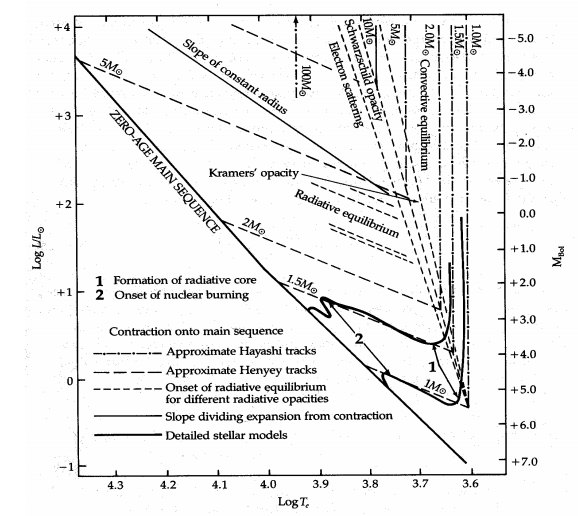Template:ASTR508/Pre-Main-Sequence Evolution
Pre-Main Sequence Evolution
Reading Assignment
Chapter 9 of Stellar-Astrophysics Notes
Star Formation
How long does star formation take?
Jean's Instablity
Stages of a protostar:
- Molecular Cloud
- Spherical accretion
- Disk accretion - T Tauri Star
- Commencement of nuclear burning - building a radiative core
- Main sequence star
Fully Convective Stars and the Hayashi Track
What happens once the bulk of the accretion has ceased and the protostar is no longer rotating quickly?
- Energy is supplied by gravitational contraction.
- The power is limited by how fast the energy can get out of the star:
- The temperature is low so the radiative opacity is high. If the temperature gradient exceeds the adiabatic gradient, convection will start.
- Convection cannot extend all the way to the surface because within a photon mean-free path of the surface, the energy will be carried by radiation and the temperature gradient will drop.
Hayashi Track
Henyey Track
As the star contracts, the centre eventually may get so hot that the radiative opacity is sufficiently small that radiation can carry the energy in the core. A central radiative zone forms.
Low Temperature Opacities
Assignment
Use the create_zams inlist to make a zero age main sequence for 47 Tucanae. In the process you will run a series of stars through the pre-main sequence for the 47 Tuc metallicity. From these models plot the protostars on a theoretical ( vs ) and observational H-R diagram ( vs ) for several masses: 0.2, 0.5, 0.7, 1, 2, 5, 8, 15 solar masses. How long do protostars of different masses take to reach the main sequence?
Using the output of the MESA runs, indicate the following on your H-R diagrams:
- the time to reach a given position along the track
- the onset of nuclear burning (say when the nuclear luminosity is one tenth of the ZAMS luminosity)
- the formation of the radiative core (how can you figure this out?).
How does the shape of the track of a low mass star differ from a higher mass star? At what mass is the transition? What does this mean?





